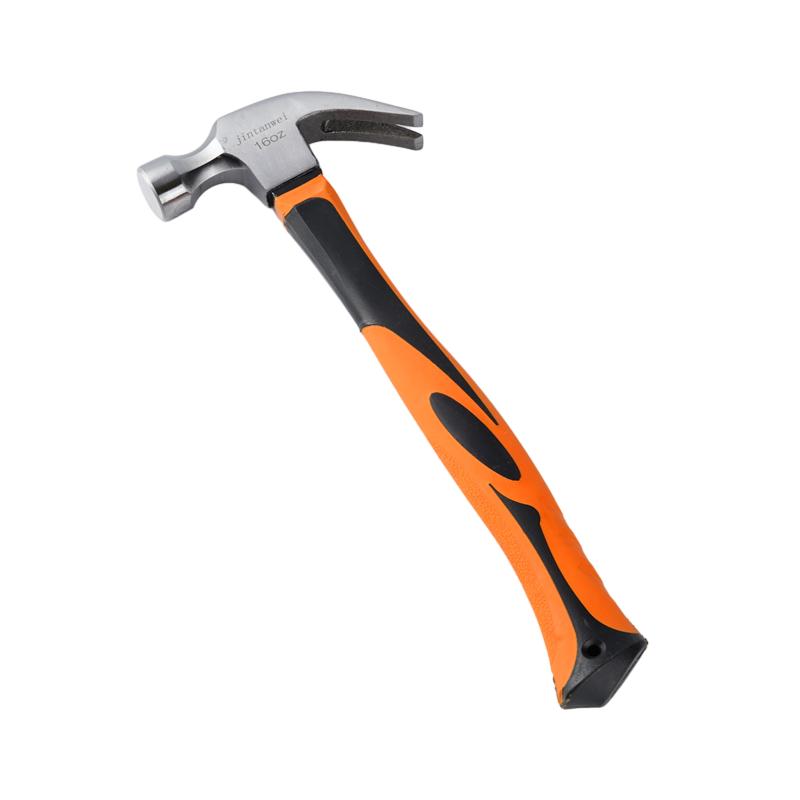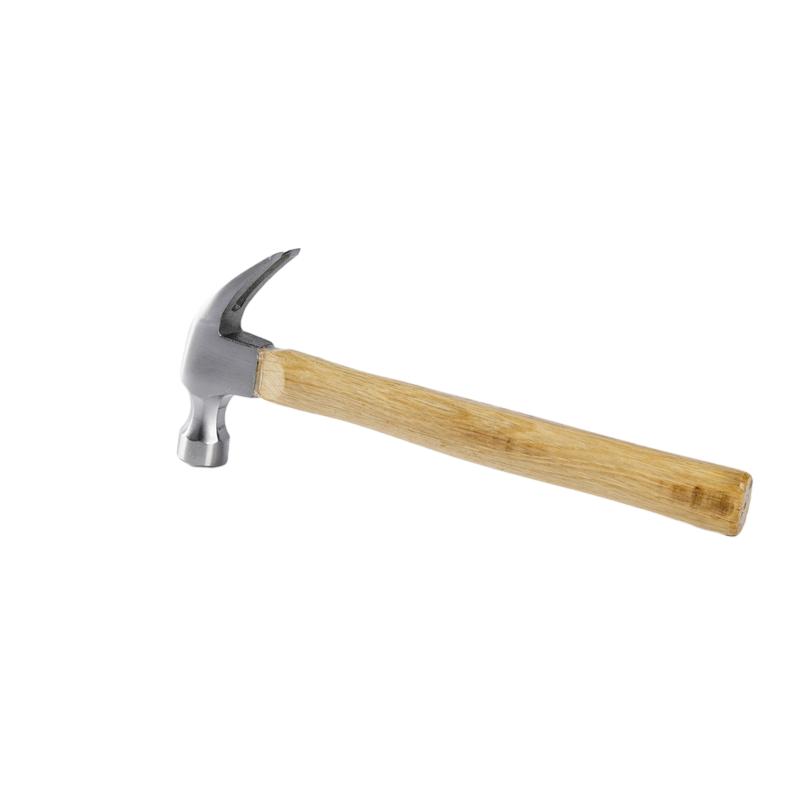This article dives deep into the world of curved claw hammers, exploring their uses, benefits, and the key factors to consider when choosing the right one for your needs. Whether you're a professional contractor like Mark Thompson or a DIY enthusiast, understanding the nuances of this essential tool will enhance your efficiency and project outcomes. This is why you should read on.
What is a Curved Claw Hammer and Why is it Essential?
A claw hammer is a fundamental tool found in almost every toolbox, characterized by its two-sided head. One side features a flat face for driving nails, while the other boasts a claw designed for pulling nails. The curved claw hammer, as the name suggests, features a claw with a pronounced curve, providing enhanced leverage for easier nail removal.
The curved claw design allows for a rocking motion when extracting nails, minimizing damage to the surrounding wood or surface. This is particularly useful in finish carpentry and woodworking, where preserving the material's appearance is crucial. Hammers, especially claw hammers, are versatile tools. They are vital for home improvement, construction, and even emergency situations, like breaking a car window.
Types of Claw Hammers: Understanding the Differences
While all claw hammers share a basic design, variations exist to cater to specific tasks. These are some of the most popular type of claw hammer.
-
Curved Claw Hammer: As discussed, this type offers superior leverage for nail extraction, ideal for finish work and delicate projects.

-
Framing Hammer: Generally heavier than curved claw hammers, framing hammers are built for heavy-duty tasks like framing houses. They often have a straight claw (rip claw) for prying boards apart.
-
Rip Claw Hammer: Features a straighter claw designed for demolition and prying, not as efficient for clean nail removal.

-
Ball Peen Hammer: Unlike claw hammers, ball peen hammers have a rounded head opposite the face, used for shaping metal and setting rivets. Explore Ball Peen Hammers Here.
What are the Key Features of a High-Quality Curved Claw Hammer?
Choosing the right claw hammer involves more than just picking one off the shelf. Consider these crucial features:
-
Head Material: Most hammer heads are made from forged steel for durability and strength. Some premium hammers utilize titanium, which is lighter but equally strong. The steel head must be heat-treated for the correct hardness. The head should be firmly seated.
-
Handle Material: Common handle materials include hickory (wood), fiberglass, and steel. Hickory offers excellent shock absorption, while fiberglass is more resistant to weather and breakage. Steel handles are the most durable but can transmit more vibration.
-
Weight: Hammer weight is measured in ounces. Lighter hammers (8-16 oz) are suitable for light-duty tasks, while heavier hammers (20 oz and up) are better for framing and demolition.
-
Grip: A comfortable and secure grip is essential for control and reducing hand fatigue. Look for handles with textured rubber or ergonomic designs.
-
Face Type: The face of the hammer can be smooth or textured (milled). A smooth face is preferred for finish work to avoid marring the surface, while a milled face provides better grip on the nail heads during driving.
How to Choose the Right Claw Hammer Handle?
The handle is a crucial component that significantly impacts comfort, control, and shock absorption.
- Wood (Hickory) Handles: Traditional and offer excellent shock absorption, reducing hand fatigue. They are susceptible to damage from moisture and overstrikes.
- Fiberglass Handles: More durable than wood and resistant to weather. They offer good shock absorption but can be less comfortable than wood for extended use.
- Steel Handles: The most durable option, often with a rubber overmold for grip and some shock absorption. They transmit more vibration than wood or fiberglass.
The handle provides the user with the necessary leverage to swing the hammer effectively and pull nails with minimal effort. Find a Variety of Handles.
What are the Best Practices for Using a Curved Claw Hammer?
Proper technique is essential for safety and efficiency:
- Grip: Hold the hammer firmly, but not too tightly, near the end of the handle for maximum leverage.
- Swing: Use a smooth, controlled swing, using your elbow and shoulder, not just your wrist.
- Driving Nails: Start with light taps to set the nail, then use full swings to drive it in. Keep your eye on the nail head.
- Pulling Nails: Place the claw around the nail head, close to the surface. Use a rocking motion, leveraging the curve of the claw, to extract the nail. For stubborn nails, use a block of wood under the hammer head for added leverage.
- The shape and form of the claw can also be used to dig things out.
How Does Claw Type Affect Hammer Performance?
The claw type—curved or straight—is a primary differentiator among claw hammers.
- Curved Claws: Provide excellent leverage for pulling nails cleanly and efficiently. The curve allows for a rocking motion that minimizes damage to the surrounding material.
- Straight Claws (Rip Claws): Designed for prying and demolition work. They are less effective for removing nails without causing damage.
The choice between a curved and straight claw depends on the intended use. For general carpentry and finish work, a curved claw is preferred. For demolition or rough framing, a straight claw is more suitable.
Are There Safety Standards for Hammers?
Yes, several organizations set safety standards for hammers, ensuring quality and user safety. These standards cover aspects like material strength, head attachment security, and handle durability.
- ANSI (American National Standards Institute): Sets standards for various tools, including hammers.
- ASTM International: Develops standards for materials, products, systems, and services, including hammer specifications.
For businesses like Mark Thompson's, sourcing hammers that meet these standards is crucial for ensuring the safety of their customers and maintaining a reputable brand image. Providing the correct certifications is a crucial part of international trade.
What are Common Mistakes to Avoid When Using a Claw Hammer?
- Overstriking: Hitting the surface instead of the nail head, damaging the material and potentially bending the nail.
- Using the Wrong Hammer: Using a light-duty hammer for heavy-duty tasks, or vice-versa, can lead to inefficiency and potential damage.
- Poor Grip: Holding the hammer too close to the head reduces leverage and control.
- Neglecting Eye Protection: Always wear safety glasses to protect your eyes from flying debris.
- Pulling Nails Incorrectly: Using a straight pulling motion instead of a rocking motion with a curved claw can damage the wood and bend the nail.
How to Maintain and Care for Your Claw Hammer?
Proper maintenance prolongs the life of your hammer and ensures safe operation:
- Inspect Regularly: Check the head for cracks or chips, and the handle for looseness or damage.
- Clean After Use: Wipe off dirt and debris to prevent rust and corrosion.
- Store Properly: Store in a dry place to prevent rust, especially for hammers with wooden handles.
- Oil Occasionally: For hammers with steel components, a light coat of oil can prevent rust.
Where Can I Find High-Quality Curved Claw Hammers?
For businesses seeking reliable suppliers of claw hammers, sourcing from manufacturers in countries like China can offer a balance of quality and competitive pricing. JTW Tools, for example, is a Chinese factory with seven production lines specializing in hammers and axes. They export to major markets like the USA, North America, Europe, and Australia. Hardware Hand Tools Household Machinist Hammer
Exhibitions are another excellent avenue for finding suppliers and inspecting products firsthand. Manufacturers like JTW Tools often participate in international trade shows, providing opportunities to connect with potential buyers.
Summary of Important Things to Remember about Claw Hammers
- The Curved Claw hammer is the preferred choice of professionals.
- Claw hammers are versatile tools with a claw for pulling nails and a face for driving them.
- Curved claw hammers offer superior leverage for nail removal.
- Choose the right hammer weight and handle material for the task.
- Proper technique and maintenance are crucial for safety and longevity.
- Source hammers from reputable suppliers that meet safety standards.
- Consider attending exhibitions to connect with manufacturers and assess product quality.
- The Hammer head is usually made from carbon steel.
- A good hammer can make a big difference to a project.
- A framing hammer is a specialized, heavy type of claw hammer with a straight claw, used primarily in framing carpentry for constructing wooden structures.
By understanding these key points, both individual users and businesses like Mark Thompson's can make informed decisions when selecting and using claw hammers, ensuring efficiency, safety, and successful project outcomes.
Post time: 03-18-2025





